SomeGuy
Veteran Member
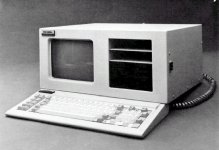
Ok, there seem to be a number of CDP VP machines around, but still not a lot of information about them.
So, lets open the box of one and see what is inside.

The Columbia VP, which stands for "Very Personal", is an IBM PC hardware clone built in to a portable (luggable) form factor. The VP attempted to offer a similar feature set as the Compaq Portable, while following in the footsteps of Columbia Data Products' desktop Model 1600 "Multi Personal Computer" IBM PC hardware clone.
It doesn't actually say VP on the front label, this is found on the model number on the back.
The machine itself is not very remarkable. Most of any fanfare seemed to revolve around the bundled "Perfect series" software products.
The VP features a similar luggable form factor to the Compaq Portable, although the VP is slightly larger and heavier.
It has a snap-on front lid that can hold any appropriately sized IBM PC/XT compatible keyboard. The keyboard plugs in to the back and uses a standard connector. Interestingly, my XT/AT switchable keyboard works without problems, although my CDP 1600 desktop didn't like it.

The CDP VP machines came with either a green or amber CRT. This option appears to be denoted as part of the unit serial number.
The machine uses standard ~200-line CGA resolution for text. Even though it has a larger screen, it does not try to improve text mode resolution as the Compaq Portable does.
The VP includes on-board CGA compatible graphics. There is no composite or RGB port to connect an external monitor. I don't know for sure if the motherboard produces composite or color, but there is a 3-wire connector that runs from the CGA section to the CRT analog board.
Columbia VP machines include dual 360k floppy drives. I have never seen one with full height drives, but the case appears to have been designed to accommodate two full height drives. Instead, the extra space is used as a "shelf", where you can store floppy disks or manuals.
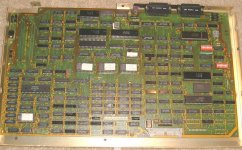
The motherboard comes with 128k of ram built in. There is a small motherboard expansion header next to the RAM, where an optional RAM board could be attached to bring the system up to 256k.
The VP includes one serial port, and one parallel port. There is also a CRT brightness adjustment knob on the back.
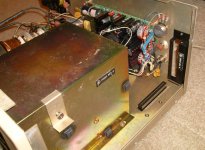
Probably the most limiting aspect of this system is that it only has one ISA slot. That means, to really expand the system you must use an all-in-one multi-function/memory card. There is room for a "wide", multi-board card.
The motherboard does have solder pads for a second ISA card, however there is no cutout in the metal, and the floppy drive and keyboard port placement does not allow room for a second card at that position. I have seen one much later revision (dated 11-84, labeled as "Model 2220-A2") that re-arranges the back ports and has the floppy drives mounted vertically instead of horizontal. Presumably this would make room for an extra card at that location.
The unit is not too difficult to disassemble, although it is a little awkward. The bottom and front of the unit are one piece of metal. The motherboard is mounted upside-down under a metal tray that screws to both the back panel and the bottom. It might seem like removing the back first would be the logical thing to do, however there are several wires that must be disconnected from the motherboard first, requiring removal of the front/bottom first.
That makes it a bit of a headache to get to the motherboard. There are several sets of dip switches on the motherboard. I don't have any specific documentation as to what they do, but if one had to make changes to those it would be a very annoying process.
I could be wrong, but it looks like there might be enough headroom UNDER the motherboard that if someone were to solder in an angled, reversed ISA socket, it might be possible to fit a tiny card such as an XT-IDE or a newer memory card. As mentioned, CDP reportedly offered a 128k memory expansion card that would fit down there.
The motherboard appears to use the same BIOS as the CDP 1600 MPC desktop. In fact the chips in this one are labeled as per the socket numbering on the 1600 MPC, not the VP. Like the CDP 1600 MPC it uses 32k bit ROMS, although the motherboard looks like it could optionally support larger ROMs.
This one came with BIOS revision 4.33. I'm still looking for for the VGA compatible 4.36 BIOS revision, although that would only be of benefit in the desktop 1600 MPC.
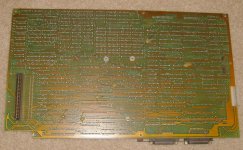
There are a number of patch wires on the back of this motherboard.
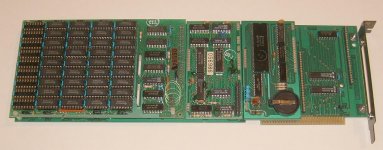
This unit came with a Maynard (Sandstar?) modular multifunction card. It is populated with enough 64k RAM chips to bring this 128k machine up to a full 640k. One remaining empty bank suggests that this card could be used with a 16k-64k IBM PC 5150 motherboard.
Although these multifunction boards often advertised the ability to replace floppy disk controller, or add hard drive controller modules, this one uses most of its space for RAM, and includes an extra serial port and a real time clock module.
The VP was followed up by the VP Plus, but the only difference I am aware of is the inclusion of the RAM expansion card, making it 256k standard.
Of course, the key feature of an IBM PC clone is how compatible it is. Columbia Data Product produced the first IBM PC hardware clone, the CDP 1600 MPC. If I understand the dates right, the Compaq Portable came out before the VP. This unit appears to have been made in very late 1983, when the clone industry was still just taking off.
So far it seems to run everything I would expect to run on a typical 8088 based PC clone. Although it only has one ISA slot, I would expect almost any IBM PC compatible card would work in it. No strange surprises in this box, and that can be a good thing.
View attachment CDP VP 4.33 Roms.zip
View attachment Maynard RTC Software.zip
